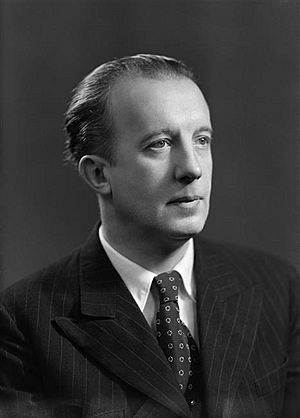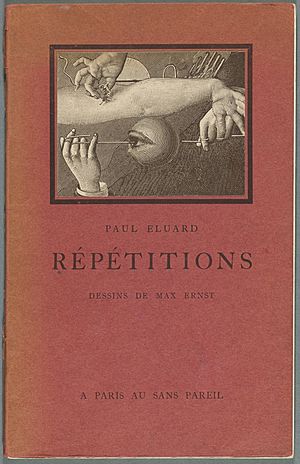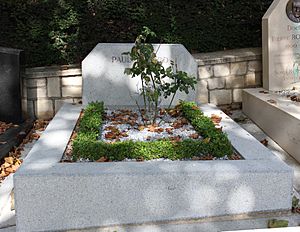Paul Éluard facts for kids
Quick facts for kids
Paul Éluard
|
|
|---|---|

Éluard c. 1945
|
|
| Born | Eugène Émile Paul Grindel 14 December 1895 Saint-Denis, France |
| Died | 18 November 1952 (aged 56) Charenton-le-Pont, France |
| Occupation | Writer |
| Period | 20th century |
| Genre | Poetry |
| Literary movement | Surrealism |
| Notable works | Liberté |
| Spouse |
Gala Dalí
(m. 1917; div. 1929)Maria Benz (Nusch)
(m. 1934; d. 1946)Dominique Lemort
(m. 1951) |
| Children | 1 |
| Signature | |
 |
|
Paul Éluard (born Eugène Émile Paul Grindel; 14 December 1895 – 18 November 1952) was a famous French poet. He was one of the key figures who started the Surrealism movement in art and literature.
In 1916, he chose the name Paul Éluard. This name came from his grandmother on his mother's side. He first joined the Dadaism movement. Later, he became a very important part of Surrealism. He also used his art to support political ideas, especially those of the Communist Party.
During World War II, Éluard wrote many poems against Nazism. These poems were secretly passed around. He became known around the world as "The Poet of Freedom." Many people consider him the most talented French Surrealist poet.
Contents
Biography
Paul Éluard was born in Saint-Denis, Seine-Saint-Denis, France. His father, Eugène Clément Grindel, was an accountant who later opened a real estate business. His mother, Jeanne-Marie, worked as a seamstress. Around 1908, his family moved to Paris.
Éluard went to school in Aulnay-sous-Bois. He later received a scholarship to attend a higher school. When he was 16, he became sick with tuberculosis. He had to stop his studies and stayed in a hospital until April 1914.
Meeting Gala
While in the hospital, he met Helena Diakonova, a young Russian girl. He called her Gala. He told her about his dream of becoming a poet. Gala believed in him and encouraged him. She became his muse, inspiring his poems. She also gave him honest feedback on his writing. During this time, he was especially inspired by the poet Walt Whitman.
In the hospital, Éluard also met Manuel Bandeira. Manuel later became a very important poet in Brazil. They became friends and stayed in touch by mail after they left the hospital.
In April 1914, Paul and Gala were both well enough to go home. Paul went back to Paris, and Gala went to Moscow. Their separation was difficult. Soon after, Europe was on the edge of war. Paul was called to join the army. Because of his health, he worked in support services. He suffered from headaches, bronchitis, and other health issues.
Paul's mother started to like Gala after hearing Paul talk about her. But Paul's father did not want Gala to come to Paris. Gala, however, was determined to be with Paul. She traveled from Moscow to Paris to study French.
War and Marriage
In June 1916, Paul was sent to a military hospital near the front lines. He had to write letters to the families of dead and wounded soldiers. He also had to dig graves at night. The horrors of war made him start writing poetry again. Gala wrote to him, promising their life would be "glorious and magnificent."
On 14 December 1916, Paul Éluard turned 21. He married Gala on 20 February 1917. Soon after, Paul decided to join the soldiers fighting in the trenches. Gala did not want him to go. But Paul felt he needed to experience a tougher life. Two days after getting married, Paul went to the front line.
Life there was very hard. Paul's health suffered. In March 1917, he was sent to a military hospital again. On 11 May 1918, Gala gave birth to their daughter, Cécile.
After the War
In 1919, Éluard wrote to Gala, "War is coming to an end. We will now fight for happiness." He published some poems about peace. He sent his poems to important writers who were against the war.
One writer, Jean Paulhan, admired his work. He told Paul about three young writers who had started a new magazine called Literature. Paul met these writers in March 1919. They were André Breton, Philippe Soupault, and Louis Aragon.
Paul was shy when he met them. He was still in his army uniform. The three poets liked his work and decided to publish one of his texts.
Dadaism and Surrealism
The four poets, affected by the war, found comfort in their friendship and poetry. They rejected the normal middle-class way of life. They did not care about money or comfort. They disliked politicians and anyone who wanted power. They wanted freedom above all else. They found a new artistic movement called Dadaism, which started in Switzerland.
In November 1921, Paul and Gala visited Max Ernst, an artist. Paul felt an immediate connection with Max. Max was also against society's rules, like Paul.
Paul and Gala moved to a house near Paris. Max Ernst joined them, entering France without legal papers. Jean Paulhan helped Max get fake identity papers.
In 1924, Éluard went through a difficult time. He disappeared for a few months. His friends worried about him. But Paul wrote to Gala, and she went to find him in Saigon and brought him back.
Political Involvement and New Love
Éluard supported the Moroccan Revolution in 1925. In January 1927, he joined the French Communist Party with other poets. During these years, he published two important works: Capitale de la douleur (1926) and L'Amour la Poésie (1929).
In 1928, he got tuberculosis again and returned to the hospital with Gala. This was their last winter together. Soon after, Gala met Salvador Dalí and stayed with him for the rest of her life.
In 1934, Éluard married Nusch (Maria Benz). She was a performer he met through his friends Man Ray and Pablo Picasso.
The years from 1931 to 1935 were very happy for him. He traveled around Europe to promote the Surrealist movement. In 1936, he protested against the Franquist uprising in Spain. The next year, the bombing of Guernica inspired his poem "Victory of Guernica." During this time, Éluard and Picasso were very close friends.
World War II and Resistance
In September 1939, Éluard joined the army again. After France surrendered in 1940, he moved to Paris with Nusch. In 1942, he secretly rejoined the French Communist Party, which was illegal.
Thousands of copies of his poem "Liberté" were dropped by British planes over Occupied France. This poem became a symbol of hope. During the war, he also wrote other poems like Les sept poèmes d'amour en guerre (1944).
In 1943, Éluard helped create a book called L'Honneur des poètes (The Honour of Poets). It contained poems by many Resistance writers. These poems spoke of hope and freedom against oppression. In November 1943, Éluard found safety in a mental hospital where many Resistance fighters and Jewish people were hiding. After the war, Éluard and Aragon were celebrated as great poets of the Resistance.
Later Life and Legacy
On 28 November 1946, Éluard learned that Nusch had died suddenly. He was very sad and depressed. Two friends helped him find the will to live again. His sadness inspired his work Le temps déborde in 1947.
He became very passionate about peace and freedom. He attended peace conferences around the world. In 1948, he convinced Pablo Picasso to join the Congress of Intellectuals for Peace. He traveled to different countries, meeting other poets like Pablo Neruda.
In 1951, he married Dominique Lemort. The same year, Éluard published Le Phénix (The Phoenix). This collection of poems was about his renewed happiness. One of his famous quotes is: "There are other worlds, but they are all inside this one."
Éluard also wrote poems supporting political leaders he believed in.
Paul Éluard died from a heart attack on 18 November 1952. He passed away at his home in Charenton-le-Pont. His funeral was held at the Père Lachaise Cemetery. The French government did not organize a national funeral for political reasons. However, thousands of people gathered in Paris to walk with his coffin to the cemetery. It was a day of mourning for many.
His poem collection, L'Évidence Poétique Habitude de la Poésie, was translated into Arabic. It was published in an Egyptian magazine in 1940.
Works

- Premiers poèmes, 1913
- Le Devoir, 1916
- Le Devoir et l'Inquiétude, 1917, (Artist's book with one etching by André Deslignères)
- "Pour Vivre ici", 1918
- Les Animaux et leurs hommes, les hommes et leurs animaux, 1920
- Répétitions, 1922
- "L'Amoureuse", 1923
- "La courbe de tes yeux", 1924
- Mourir de ne pas mourir, 1924
- Au défaut du silence, 1925
- "Place du Tertre", 1925, peinture à l'huile
- "La Dame de carreau", 1926
- Capitale de la douleur, 1926
- Les Dessous d'une vie ou la Pyramide humaine, 1926
- L'Amour la Poésie, 1929
- Ralentir travaux, 1930, in collaboration with André Breton and René Char
- À toute épreuve, 1930
- "L'immaculée conception", 1930
- Défense de savoir, 1932
- La Vie immédiate, 1932
- La Rose publique, 1934
- Facile, 1935
- Les Yeux fertiles, 1936
- Quelques-uns des mots qui jusqu'ici m'étaient mystérieusement interdits, 1937
- L'Évidence Poétique Habitude de la Poésie, 1937
- "Les Mains libres" in collaboration with Man Ray, 1938
- Cours naturel, 1938
- "La victoire de Guernica" 1938
- Donner à voir, 1939
- "Je ne suis pas seul", 1939
- "Le Livre ouvert" 1941
- Poésie et vérité 1942, 1942
- "Liberté", 1942
- Avis, 1943
- "Courage", 1943
- Les Sept poèmes d'amour en guerre, 1943
- Au rendez-vous allemand, 1944
- Poésie ininterrompue, 1946
- Le Cinquième Poème visible, 1947
- Notre vie, 1947
- À l'intérieur de la vue, 1947
- La Courbe de tes yeux, 1947
- Le temps déborde, 1947
- Ode à Staline, 1950
- Le Phénix, 1951
- Picasso, dessins, 1952
Selected translations into English
- Eluard, Paul; Kendall, Stuart (2007). Paul Eluard - Love, Poetry. Black Widow Press. ISBN 9780976844976. OCLC 81252722. Bilingual edition of L'amour la poesie (1929). Includes Stuart Kendall's English translations and introduction.
See also
 In Spanish: Paul Éluard para niños
In Spanish: Paul Éluard para niños


